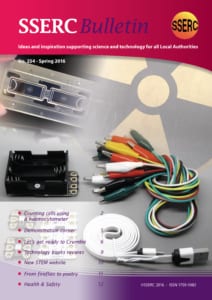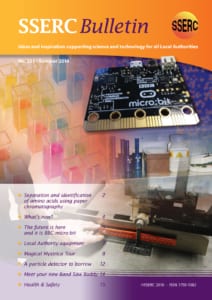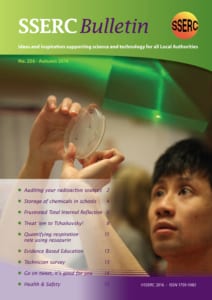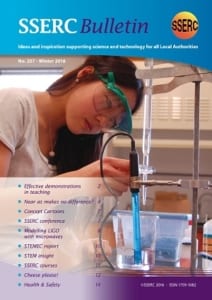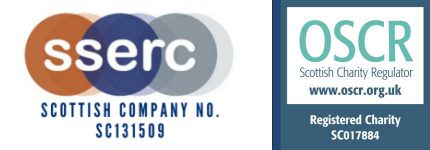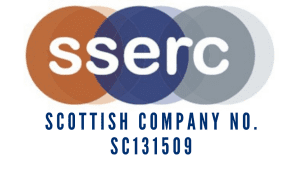Counting cells using a haemocytometer
An introduction to the disposable plastic C-Chip™ haemocytometer and how to use this for counting cells under a microscope.
Demonstration corner – Golden Rain
This is a beautiful demonstration that is a lovely introduction to discussions about precipitation and solubility. Warm solutions of potqassium iodide and lead nitrate are mixed. As they cool crystals of lead iodide appear and sparkle beautifully if a strong light is shone on the solution as they settle to the bottom.
Let’s get ready to Crumble
The Crumble controller is cheap, easy-to-use and an ideal way to introduce electronic control and circuits to BGE classes. After starting out with a Crumble Controller, all you require is the addition of a battery power source, a micro USB cable from the PC, a number of croc leads and sparkle LEDs and you are ready to begin.
Technology Book Reviews
Reviews of two new books relating to the Raspberry Pi – Adventures in Raspberry Pi by Carrie Anne Philbin and Make: A Raspberry Pi Controlled Robot (3rd Edition) by Wolfram Donat
New STEM website
In December 2015, the National Science Learning Network and National STEM Centre teamed up and created a new website: www.stem.org.uk.
From fireflies to poetry
One of the activities which SSERC offers to schools and colleges is a demonstration lecture entitled ‘From Sellotape® to Fireflies: things that glow in the dark!’.
Health and Safety
Health and Safety update
Updates on:
Electrical safety of mains adaptors
Separation and Isolation of Amino Acids
Paper chromatography of amino acids is one of the practical learning activities suggested in Higher Biology. This article gives details of a suitable experimental protocol for carrying out the procedure. It is also available for download from the SSERC website and has been adapted from one produced by Dart Publishing in 1996. Please read the accompanying health and safety guidelines prior to starting this procedure.
The Future is here and it is BBC Micro:bit
An introductio to the BBC Micro:bit microcomputer that is being given out to all S1 students across the country as part of a UK wide initiative to raise the profile of coding in schools.
SSERC Local Authority equipment
As was the case in 2015, SSERC has been able to source pieces of science and technology equipment which we will give to local authorities on a permanent loan basis. Further details of the various items are given in the articles that follow.
Magical Mystrica Tour
To go along with the upgrading of the provision of Mystrica Colorimeters in Local Authorities, this article gives some information about the use of the new Mystrics Mark II and how to use it for automated colorimetry in connection with PCs and mobile devices.
A Particle Detector for you to Borrow
SSERC has been given a new piece of apparatus to lend to schools. We think you and your students are going to like it. It is a particle detector, capable of detecting alpha, beta and gamma radiation and other types such as muons.
Band Saw Buddy
SSERC has purchased an Axminster Tools Band Saw Buddy for every Technical Education department in Scotland. The tool is extremely well manufactured here in the UK and handy to have attached to the band saw whilst working in a school work shop.
Health and Safety
Radiation protection – how is your record-keeping?
For reason s that are not entirely clear, we have had a flurry of requests for approval to buy new items. This is probably a good time to remind you of what you should be doing if you own sources, with particular regard to checking, testing and record-keeping. Here is a summary.
Demonstrating Frustrated Total Internal Reflection
A good practical activity for Advanced Higher as FTIR has strong similarities to quantum tunnelling.
Treat ’em to Tchaikovsky
A fun take on a clock reaction. As well as the interesting (and quite challenging) chemistry involved, this version sets the additional challenge of trying to get flasks to change colour at exact points during a piece of music.
Quantifying respiration rate using resazurin
Within the biology curriculum, at National 5 and Higher, it is suggested that learners might use the colour changes of resazurin dye as a measure of respiration rate, or dehydrogenase activity, in yeast.
In this article we look at some approaches to carrying out this experiment.
Evidence Based Education
Decision making in education should be based on sound research evidence and should be the concern of every teacher. This new publication written by Jim Stafford describes the main methods for collecting evidence on which to base decisions.
Go on tweet, it’s good for you!
Using Twitter as a departmental information tool can offer lots of benefits to Technology teachers, whole departments and their pupils. Here we analyse five of those benefits and how they can help you at school.
Health and Safety
Auditing your radioactive sources
In Bulletin 255, we reminded users of radioactive materials in schools of the administrative procedures they should be carrying out in order to work safely and comply with the law. In this issue, we look at the sorts of sources that are permitted for use in schools.
Storage of chemicals in schools
A guide to some of the legislation covering the safe storage of chemicals in schools and some of the issues that we are coming across.
For your eyes only
One of the most frequent requests for guidance that we receive is for information on protective eyewear. Here we breakdown the information from BS 4163:2014 to help you make the right choice in the workshop.
Air weapons in schools
A forthcoming change in the law will affect any school whose physics department owns an air rifle. Section 2 of the Air Weapon and Licensing (Scotland) Act 2015, which comes into effect on December 31st 2016, makes it an offence for a person to use, possess, purchase or acquire an air weapon without holding a certificate.
Effective Demonstrations in Teaching
An introduction to the art of the demonstration as a pedagogical tool
Near as Makes No Difference
A look at some methods of carrying out titrations on a small or micro scale and an analysis of their accuracy.
Concept Cartoons
An event at SSERC held by Stuart Naylor – the guiding light behind Concept Cartoons.
Modelling LIGO with microwaves
LIGO, the Laser Interferometer Gravitational-Wave Observatory, uses a Michelson Interferometer set-up to
detect tiny movements of a mirror caused by space stretching when a gravitational wave passes. Whereas LIGO depends on the interference of laser light, our version uses microwaves of wavelength 2.8 cm.
STEMEC Report
STEMEC (The Science, Technology, Engineering and Mathematics Committee) has recently published its final report – here is a summary of the findings.
SSERC Professional Development
Our professional development courses range from twilight events, day-courses through to residential meetings lasting up to 6 days in total. Our curriculum coverage spans both primary and secondary sectors and we offer events for teachers as part of their career long professional learning, newly qualified teachers and technicians. Many of our events receive funding from the ENTHUSE awards scheme or the Scottish Government.
A limiting factor in many biology experiments is finding a reliable end point in a practical investigation or experiment. One such practical activity involves the milk clotting time associated with cheese making.
Health and Safety
Bacteria Farm Safety Alert and Enzymes
An alert about the the inherent hazards associated with the activities mentioned in the product description for this kit. And an introduction to a new Topic on Enzymes from the ASE’s Health and Safety Committee.
Night and Day reaction
A warning about the dangers of this reaction, hitherto safe, as a result of some new reagent formulations.

